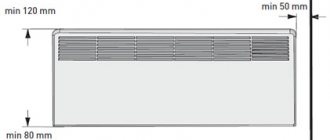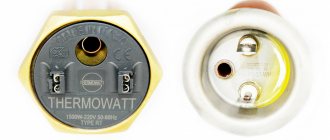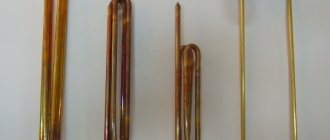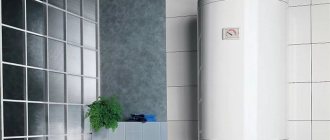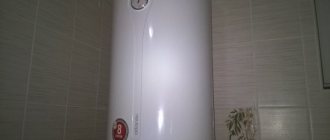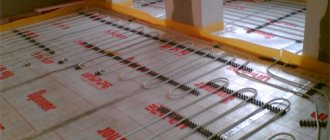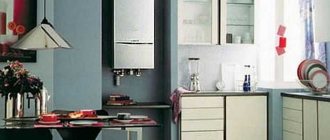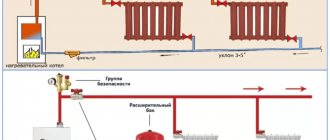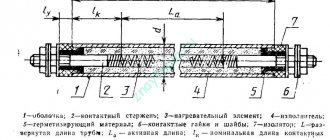Many people cannot imagine their life without hot water supply. But apartments do not always provide uninterrupted service to the population with these benefits. Private houses also need additional heating equipment. Therefore, the solution would be to purchase an electric storage water heater. For urban housing with a family of three people, a boiler with a tank volume of 50 to 100 liters is suitable. For country cottages, dachas, small cafes, you can take a 30-liter unit. But before you buy such a unit, you need to make sure that the design, characteristics, and capabilities of the water heater fully meet the buyer’s requirements.
How to properly replace the heating element in a boiler
A part is replaced if it breaks due to lack of regular cleaning of the boiler
The need to replace the heating element arises when it malfunctions. When it stops heating the water, the electrical protection device is triggered. The average service life is 4 years. Then it fails due to increased water hardness. This event can be delayed if you perform annual boiler maintenance: clean the heating element and magnesium anode from scale. This operation will increase the duration of operation and improve the quality of water and the rate of its heating. Before purchasing a new element, you should check the condition of the old heating element using a test lamp or multimeter. In the first case, a simple electrical circuit is assembled, including a lamp and a heater. If the light is on, it is not the problem. In the second case, the resistance is measured with a special device. A zero value indicates a heater malfunction.
The designs of different boiler models have minor differences, but the principle of replacing heating elements in a water heater is the same for all types of devices.
To begin with, turn off the water supply and drain the remaining liquid from the boiler. The water heater must be de-energized by unplugging the plug from the socket. At the bottom of the boiler there is a cover that is attached with screws. You need to unscrew them with a screwdriver and the cover will come off. For safety reasons, before you start replacing the heating element in the boiler, you need to check the presence of voltage at the terminals, for example, using an indicator screwdriver. Then disconnect the wires and unscrew the nuts holding the heater in place. Replace the heating element on the water heater, first checking that the contacts are dry. If an anode is installed in the boiler, replace it as well. Check the seal for leaks and screw the lid into place. After these manipulations, you need to fill the boiler with cold water and bleed the air from it by opening the hot water tap. Only now can you turn it on to the network.
Installation Tips
To avoid installation errors, use the following tips:
- If you are installing another thermostat (not in the form of a metal rod), then its installation will be carried out using a similar method - the thermostat is built into the electrical circuit break on the phase wire that goes to the heating element. More detailed installation instructions can be found on the packaging.
- Before purchasing, be sure to check the operating voltage of the thermostat. There are devices on sale that work not only with 220 V, but with other voltage levels (24, 127, 380 and others). You can also check the technical parameters with the seller or look at the packaging.
- Do not rush to buy a device with maximum sensitivity. For most everyday tasks, a sensitivity of 0.5-2 degrees will be sufficient. Of course, no one will forbid you to buy more accurate devices, but they usually cost several times more, and they will be of little practical use.
Criterias of choice
When choosing a heating element for a boiler, you need to build on the characteristics of the previously installed element.
Types of devices
The material of the tank and heating element must match, so stainless steel parts are often purchased
. In addition to the type of heating element in contact with liquid, you need to take into account a lot of other parameters:
Mounting method: nut or flange. The latter can be cast or stamped. Flange mounting is typical for open-type heating elements; Possibility of installing an anode - this element is designed to protect metal surfaces from corrosion and scale, thereby increasing the overall service life of the boiler. The anode gradually “melts”, so a new one must be installed periodically. If there is a hole for the anode in the base of the heating element, then a new heater with the same hole is needed. The shape depends on the type of storage container. The heating element can be straight or bent. A heating element similar to the previously installed one is selected, taking into account not only the shape, but also the size, as well as the bending angle. Manufacturing material - the outer surface of the heating element can be made of copper or stainless steel
It is important that the material of the tank and heating element match, otherwise, due to the difference in potential, the service life of the heating element and the tank itself will be shortened. A closed-type copper heater can be located inside an enameled steel flask, in which case you don’t have to worry about creating a galvanic couple.
Features and amount of heated liquid
Heating element with magnesium anode for hard water
If the water is hard, you need a heating element under the anode, which will partially eliminate the problem of scale and extend the life of the boiler. The power must correspond to the volume of the heated liquid. It is recommended to purchase a part of the same power as the failed one. The heater parameters are indicated in the technical data sheet of the device.
terms of Use
The power must match the wiring capabilities. But this applies more to the choice of a boiler rather than a heating element, since the old element is replaced with a new one of similar power. The power of the boiler as a whole also affects the heating rate of a given volume of water. If the heating element is low-power, for example 1000 W, and the capacity is 80 or even 100 liters, it will take a very long time for the water to heat up to the maximum temperature, several hours, so you need to turn on the boiler in advance. This power is optimal for small boilers, up to a maximum of 50 liters.
If you plan to consume a lot of hot water, it is recommended to buy a model with two heating elements. They heat the water faster. In economical mode, one element will work, and the second will be connected thanks to the thermostat when it is necessary to heat a new portion of cold water.
Categories of heating elements by type of contact with liquid
In a dry heating element there is no contact with water, which extends the service life of the part
A nichrome spiral is hermetically sealed inside the heating element for heating water, and the space between it and the outer walls is filled with quartz sand. The outer tube can be made of copper, carbon steel or stainless steel.
Open heating elements come into direct contact with water. Their main advantage is the high speed of heating the liquid and low cost, but there are also significant disadvantages:
- limited service life;
- rapid formation of limescale;
- high electricity consumption;
- insecurity.
Closed ones do not come into contact with water. The heating element is protected by a durable bulb. Its advantages:
- the likelihood of an electrical short circuit is reduced;
- easy to repair and maintain;
- serve for a long time - three times longer than open heating elements;
- consume significantly less electricity than open-type heating elements.
There are two important disadvantages: high price and slow water heating.
Design Features
Cold water entering the storage water heater through specially supplied and connected channels is heated thanks to the heating element to the previously set temperature using temperature control.
Did you know that...
A dry heating element (tubular electric heater) for water heaters is a hollow tube hidden in a ceramic flask, surrounded by an anti-corrosion layer. Inside the tube there is a wire made of a special alloy. Thanks to the electric current supplied to the rod, the heating element heats up and gives off heat to objects around it. Between the wire and the tube there is quartz sand, which has dielectric properties, increasing the electrical safety of this equipment.
How to connect a heating element with a thermostat
Now you know how and by what parameters heaters are selected. But how is the connection made? In order to connect a heating element with a thermostat, you must select a wire with reliable insulation
We also pay attention to the cross-section - it must be such that the wire can provide adequate power to the heater and not melt. For example, for a 3 kW heater, the wire cross-section must be at least 2.5 mm. We recommend choosing cables with copper conductors for connection
Do not forget to pay attention to the presence of an RCD - it will instantly turn off the power in the event of an unexpected failure of the heating element or a short circuit. The RCD must be installed as close as possible to the heater itself
You should also ensure a reliable connection of the conductors with the contacts of the heating element (without “snot” and flimsy contacts that can spark).
Temperature regulators are used quite widely for domestic purposes, and they regulate the temperature literally everywhere: from a common soldering iron to the microclimate in the house.
Advantages of dry heating elements
If you compare a dry design with a submersible one, the first one will have a lot of advantages:
- no scale;
- compact dimensions;
- ease of maintenance;
- excellent performance;
- long service life;
- no air pockets.
The main problem with all water heaters is scale.
The reason for the formation of this layer is poor quality water and the fact that the surface of the heater comes into contact with the liquid. Harder water causes scale to form much faster, and the lime layer is thicker and denser. Because of this phenomenon, the heating rate is significantly reduced, and the service life of even the most expensive water heater is noticeably reduced. The dry structure is reliably protected from such troubles, since there is no contact with water, which means scale cannot form.
Since most developers allocate catastrophically little space to the toilet and bathroom, the second important criterion for choosing a boiler is its size. The dry heating element has quite miniature dimensions in comparison with its “wet” relative. Since the size of the water heater itself is significantly reduced, it is not unreasonable for the manufacturer to install two or even three heating elements, which allows the consumer, if desired, to heat the water in just a few minutes. Moreover, the consumer is not afraid of interruptions in the operation of one of the heaters, since he can always use the remaining ones.
High performance and easy maintenance
Since scale does not form on a dry element, the speed of obtaining hot water increases significantly.
The water heater does not spend a large amount of energy to fulfill its direct responsibility, which puts a dry heating element a step higher in comparison with a wet one. Another important feature of the tubular element is the ease of repair. Despite the fact that such an element is durable, it can still fail. In order to repair the device, you do not need to completely dismantle the tank. You just need to unscrew the protection and remove the element. After inspection and repair, the heating element is put back. According to a similar scheme, the tank is cleaned of scale every six months. In this case, the heating element is not affected, and only the inner wall of the tank is cleaned.
Water heater durability
Due to the fact that the heating element itself does not come into contact with water and is not covered with scale, its service life can last for 5-6 years, while a submersible heating element will have to be changed every 2 years.
With current prices for components, this advantage allows you to save a lot of money, even though a water heater with a dry heating element costs an order of magnitude more. Manufacturers also made sure that the boiler does not turn on if there is no water in it at the moment. Dry start protection is installed in absolutely all water heaters with a dry element. This function allows the unit not to burn out and last longer.
If you still need to repair the element, the variability of such a water heater will be a pleasant surprise. Tubular heating elements differ little from each other, so finding the right part will not be difficult.
Disadvantages of dry electric heaters
There is a misconception that dry heaters are uneconomical due to the gap between the protective bulb and the resistive element. First, the tube warms up, and only then the liquid. Experts confidently refute this opinion. Heat transfer occurs within the environment, so heat loss is minimal. The diameter of the heating element is 2 millimeters smaller than the diameter of the protective flask, the air gap is small.
The power ratings of dry heating elements are lower than those of conventional heating elements. Their power reaches 1200 W, versus the usual 2 kW. But dry heating elements can be installed 2 pieces per boiler, the overall difference in power in this case is insignificant.
Purpose of heating elements
Why do we need heating elements with thermostats? Based on them, autonomous heating systems are designed, boilers and instantaneous water heaters are created.
For example, heating elements are mounted directly into batteries, resulting in sections that can operate independently, without a heating boiler. Some models are focused on creating anti-freeze systems - they maintain a low positive temperature, preventing freezing and subsequent rupture of pipes and batteries.
This battery has a built-in heating element with a thermostat, with its help the house is heated.
Storage and instantaneous water heaters are created on the basis of heating elements. Purchasing a boiler is not affordable for every person, so many assemble them themselves using separate components. By installing a heating element with a thermostat into a suitable container, we will get an excellent storage-type water heater - the consumer will only have to equip it with good thermal insulation and connect it to the water supply.
Bulk-type storage water heaters are also being created on the basis of heating elements. In fact, it is a container of water that is filled manually. Heating elements are also built into summer shower tanks, ensuring water heating to a given temperature in bad weather.
Heating elements for heating water with a thermostat are necessary not only for creating water heating equipment, but also for repairing it - if the heater fails, we buy a new one and replace it. But before that, you need to understand the issues of choice.
Division of dry heater by class
Electric heating elements are also divided depending on the design of the boiler. A storage water heater with a dry heater allows the use of less durable and wear-resistant structures.
Such heaters are cheaper, but also last less. A flow-through boiler will require heating elements that can withstand the load created by the moving medium well.
Popular manufacturers
Each boiler manufacturer produces heating elements only for its own equipment.
You should choose heating elements from a trusted manufacturer. This is not an element you need to skimp on. The best companies include:
- Thermex. It has been producing boilers for almost 50 years. This manufacturer produces heating elements from copper and stainless steel. They are reliably protected and therefore have a long service life. In the market, Termex has established itself as a manufacturer of boilers of the largest volume, so you can find powerful electric heaters in its assortment.
- Ariston. The heating elements from the Italian manufacturer are made of an alloy containing copper and equipped with a chromium-nickel tube. The flange is made of brass, which increases heat transfer. They are well protected from scale and easy to install. And at the same time they are relatively inexpensive. Ariston offers water heating heating elements with threads and a thermostat from 1.2 to 4.5 kW.
- Electrolux. You can choose a heating element from this manufacturer for almost any heater model. At the same time, they are guaranteed to last a long time, since they are especially resistant to scale and are not demanding on water quality. A water heater with a heating element from Electrolux does not require frequent maintenance. Some devices from this manufacturer are equipped with two closed heating elements, so it is possible to increase the heating rate of the liquid.
- Timberk. Another manufacturer that offers its products at an affordable price. The assortment includes heating elements designed for boilers with 80 or more liters of water. They are well protected from corrosion and other destructive factors.
- The company Atlantic is also known. It produces a wide range of high-quality and reliable heating elements for boilers, including copper water heating elements, dry soapstone and others, suitable for vertical and horizontal installation.
Each manufacturer produces electric heaters designed for installation in boilers of their own production. However, you can also find universal heating elements. They are less popular due to their dubious quality, but their use is possible.
Review of the best models
If you still decide to give preference to a storage water heater with a dry heating element, we bring to your attention the TOP 5 best models of 2022.
Atlantic Vertigo
An innovative co-production model between Egypt and France. The design of this water heater is unique and so far no brand has been able to replicate it. "Vertigo" has two enameled tanks for heating water. The unit operates absolutely silently and is controlled using a clear digital interface.
Advantages:
- equipped with a thermostat, which will allow you to heat the water only to the desired temperature;
- for those who are in a hurry, Boost high-speed heating is provided;
- the smart unit remembers the settings and turns on the device in Smart mode with the parameters that the user sets most often;
- wide range of models, up to 80 liters inclusive;
- long operation is ensured by the presence of dry heating elements and a magnesium anode;
- there is the possibility of both vertical and horizontal installation;
- tank warranty period – 7 years;
- All models have a depth of no more than 30 cm.
Flaws:
- There are no models with a volume of more than 80 liters in the size range, which can be inconvenient for a large family.
Reviews on Yandex.Market
See also:
- 6 best Hotpoint-Ariston water heaters
- 8 Best Zanussi Water Heaters of 2022
- 8 Best Thermex Water Heaters of 2022
- 10 Best Timberk Water Heaters of 2022
- 10 Best Gorenje Water Heaters of 2022
Electrolux EWH 50 Formax DL
Electric water heater with two dry-type heating elements, power 1.2 and 0.8 kW. There is an informative digital display and a three-mode heating temperature control function. Maximum water heating is up to 75 C, optimal operating temperature is 55 C. The tank has a fairly thick layer of polyurethane (22 mm) to protect against freezing.
Pros:
- good thermal effect, water stays hot for a long time;
- compact dimensions;
- three operating modes;
- quick heating of water to the desired temperature;
- aesthetic appearance;
- quite affordable price.
Minuses:
- Based on reviews from users and specialists, no obvious shortcomings were identified.
Reviews on Yandex.Market
Fagor CB ECO
High-quality water heater from a Spanish manufacturer. Equipped with two dry TEEs of 1.2 or 0.8 kW depending on the tank volume. There is a wide range of models from 30 to 200 liters of tank volume. The design of the unit provides several control modes. Depending on the specified parameters, heating elements can work in pairs, one at a time or in automatic mode.
Advantages:
- wide volume range of models;
- Heating elements operating on the principle of dry heating;
- improved thermal insulation system;
- titanium anode that does not require replacement;
- durable steel tank with additional titanium coating;
- provides for the possibility of horizontal and vertical installation;
- long warranty periods;
- Electronic regulation allows you to control the temperature with an accuracy of a degree.
Flaws:
- in ECO mode there is no possibility to independently set the desired temperature;
- The power cord is not long enough.
Reviews on Yandex.Market
Gorenje OGBS100SMV9
A good middle-class water heater from a Serbian manufacturer. The model has a flat white body, which is compatible with almost any interior design. The model is equipped with a modern overheating system, which eliminates accidental activation with an empty tank. To protect against corrosion, a magnesium anode is installed in the tank.
Pros:
- electronic control system;
- dry heating element;
- “smart” system for remembering regular user settings;
- wide range of models from 30 to 120 liters;
- maximum heating temperature +85C;
- affordable pricing policy.
Minuses:
- There is only a vertical installation method;
- The inside of the tank is covered with enamel.
Reviews on Yandex.Market
Types of heating elements according to operating principle
The features of open and closed heating elements are clear from the name. The former are not protected from water, the latter are covered with a flask. They are also called wet and dry. The principle of their operation should be considered in more detail.
Wet
Wet-type heating elements are tubular, they are in direct contact with water and heat the water with their surface. Their service life depends on the quality of the water, its hardness, and the percentage of salts. Due to the influence of these factors, the metal corrodes, and limescale forms on the surface. By installing a magnesium anode, the process can be slowed down, since the element attracts salts. Vitreous enamel is also used to protect water heating tubes.
Dry
A dry heating element is a heater that is placed in a flask filled with a second layer of ceramic backfill (the first layer fills the space between the nichrome spiral and the tube in which it is placed). The waterproof shell is made of magnesium silicate or steatite. Soapstone heats up quickly and cools down slowly, has increased strength and high heat resistance. The advantages of using a dry heating element in a water heater outweigh the disadvantages, and in particular, to replace such a heating element, you do not need to drain the water from the boiler.
Features of caring for dry heating elements
Our company produces high-quality dry ETHs characterized by a high level of protection when operating in a liquid environment. But, the client must understand that timely maintenance extends the life of any heater. Heating surfaces must undergo regular inspection and be cleaned of all kinds of contaminants. The frequency of maintenance depends on the environment in which the heater operates and the degree of contamination.
When operating flexible heating elements, it is necessary to use protective paste at the points of contact of the heating device. Before starting the equipment, it is necessary to remove any grease that interferes with optimal heat transfer.
Connection methods
It should be noted that heating elements for boilers can be mounted into the device either one at a time or several at once.
Parallel connection
This connection option must meet certain requirements.
The basic rules are as follows:
- The voltage both in the electrical network and in each individual element must be the same.
- To determine the total power of the boiler, you need to sum up the powers of all installed elements.
- If for a certain reason one of the heating elements breaks, the circuit will continue to operate. In this case, the only thing that needs to be done is to replace the broken element.
Serial connection
The second option is a serial connection. In this case, it is necessary to follow the operating principles:
- If one of the heating elements breaks, the operation of the entire network will be interrupted.
- To find out the total resistance, you need to sum up all the resistances in the network.
- The total voltage cannot be greater than the total voltage of all heating elements.
Combined method
Taking into account this diagram, different connection options must be used in several sections of the electrical circuit. Quite often, a combined method is advisable if it is impossible to purchase heating elements of the required power. In this case, available heating elements are installed, and the required value is achieved using various connection methods.
Selecting a heating element
When choosing a heating element, you need to pay attention to some details. Only in this case can you count on a successful purchase, high-quality heating, long service life and compatibility of the selected model with a water heating tank, boiler or radiator
Shape and size
There are dozens of heating element models available for buyers to choose from. They have different shapes - straight, round, figure-eight or ear-shaped, double, triple and many others. When purchasing, you should focus on the use of the heater. For installation in sections of heating radiators, narrow and straight models are used, since there is quite little space inside
When assembling a storage water heater, you should pay attention to the volume and shape of the tank, and based on this, choose a suitable heating element. In principle, almost any model will fit here
If you need to replace a heating element in an existing water heater, you need to purchase an identical model - only in this case can you count on the fact that it will fit into the tank itself.
Power
If not everything, then a lot depends on power. For example, this could be the heating rate. If you are assembling a small-volume water heater, the recommended power will be 1.5 kW. The same heating element will be able to heat disproportionately large volumes, but it will do this for a very long time - with a power of 2 kW, heating 100-150 liters of water can take 3.5 - 4 hours (not to a boil, but on average by 40 degrees).
If you equip a water heater or water tank with a powerful 5-7 kW heating element, the water will heat up very quickly. But another problem will arise - the house electrical network will not withstand it. When the power of the connected equipment is above 2 kW, it is necessary to lay a separate line from the electrical panel.
Protection against corrosion and scale
When choosing heating elements for heating water with a thermostat, we recommend paying attention to modern models equipped with scale protection. Recently, models with enamel coating have begun to appear on the market.
It is this that protects the heaters from salt deposits. The warranty on such heating elements is 15 years. If you don’t find similar models in the store, then we recommend purchasing stainless steel electric heaters - they are more durable and reliable.
The right choice: what we pay attention to
We advise you to take into account 5 criteria that will help you buy a really good water heater.
Form
The main thing here is not so much the aesthetic side, but the ability to place the heater in the right place:
- cylindrical - round in shape (like a “barrel”), this design does not have sharp corners and is aesthetically pleasing. Due to the convex shape, it does not fit flush against the wall;
- rectangular - elongated, small-width devices can easily be installed in a cabinet under the sink. They fit against the wall with minimal gaps;
- slim tanks - such as the BLU1 R 50 V 1.5 are distinguished by a narrowed oval shape, so they take up minimal space.
Volume
It is worth choosing depending on the number of household members and planned use cases. Let's say to take a shower and wash dishes you will need:
- 30 l. - per consumer;
- 50-60 l. — for 2 users;
- 80 l. — for 3 people;
- 100 l. units (example - S100ORFEUSDH) are suitable for four. Enough for a soak in the bathroom, for a shower, and for washing mountains of dirty dishes.
Useful article: How to choose a boiler: 9 main criteria for a quality device
Power
You need to take into account the load the network in the apartment is designed for, otherwise traffic jams will blow up. The water heating time depends on this criterion. We also do not forget that the heating volume and temperature differ in different devices. Therefore, it is necessary to consider these parameters comprehensively. Let’s say an 80-liter Ariston with 1800 W can handle heating to 80 °C in 2.1 hours. While a 150 liter Gorenje at 2000 W will take almost 6 hours to heat up to 85 °C.
In order not to rack your brain with calculations, study the technical characteristics of the heating unit. They accurately indicate the power and heating time.
Material
In budget options (S50SYMPHONY2.0) the tank is covered with enamel. It is characterized by good thermal insulation and resists the appearance of scale and corrosion for a long time.
More expensive models have a steel body with different coatings:
- titanium - resistant to high temperatures and high pressure. Such boilers heat up quickly and evenly;
- enamel (as in OGBS 120SM) - combines with metal, which increases its resistance to deformation from heat, and also repels scale. To make it dissolve, a magnesium anode is used at the bottom of the tank;
- glass-ceramic - resistant to chemicals, temperature changes and pressure. If scale forms, it is in a minimal amount.
For information: steel units coated with silver provide an antibacterial effect and protection against the appearance of microcracks when heated.
Detailed article: Instructions in 4 points, which water heater is better - instantaneous or storage
Installation type
Boilers with dry heating elements are installed on the wall in two ways.
- Vertically - when the heater takes up more space in length than in width. Most devices are mounted this way. Due to the fact that heated water does not come into contact with cold water, the tank cools down more slowly. Because the principle works, just like with heated air: warm things rise, cold things fall.
- Horizontally - a suitable option for small spaces. In a horizontal position, you need space on the left or right, so the unit is usually suspended from the ceiling. But some models heat up faster.
Universal tanks support several types of installation (for example, GBFU150SIMV9). But their cost is higher than average.
Useful article: How to use a boiler. Operating rules: 3 main points
